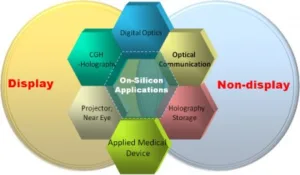We recently had a chance to visit with Jasper Display in their Santa Clara offices. Jasper is a silicon design house that started by specializing in Liquid Crystal on Silicon (LCoS) microdisplay. They still do this and have a 4K LCOS panel, but we also learned that LCOS and the underlying silicon backplane technology is enabling applications in a dozen other markets.
Jasper was clear to state that is not in the LCOS microdisplay business, but are in the “X-on-silicon” business. That means their expertise is in silicon backplane design that then mates to other material frontplanes including liquid crystal. This includes display and non-display applications, amplitude and phase modulation and multiple frontplane technologies (Liquid Crystal on Silicon, micro-LEDs on silicon, OLED on silicon, polymer on silicon, etc.), as illustrated in the graphic below.

With LCoS, the company has a lot of experience. In this case, they design the silicon backplane and have it fabricated at a contract foundry. A second facility adds the liquid crystal frontplane to create the “cell”. Jasper then does the packaging part to create a liquid crystal module. This combination of IC design/fab and packaging is combined into what they call a “mini-Fab” – a class 100 clean room facility. It is the basis for supporting all kinds of products in other industries as well.
Jasper Display’s VP, Marketing & Engineering, Mike Stover, explained that their LCOS panels can support a lot of applications because they can be phase or amplitude modulated and they have a very high pixel density, along with very high data transfer bandwidth. For example, LCoS is very popular in holographic projection where the LCoS panel is a phase modulator that directs light only into the letters or symbology being displayed. This makes it quite attractive for Head-Up Displays (HUDs) and augmented reality applications where limited information and high brightness are prized.
Stover also noted that LCOS is being used in wavelength selective switch applications in telecommunications. They are likewise working with the Centre for Advanced Photonics and Electronics (CAPE – University of Cambridge) for optical switches for data centers. LCOS spatial light modulators (SLM) are finding use in microscopy applications and holographic data storage. Structured light applications are another area where LCOS SLMs can create the light patterns needed for 3D capture systems. Stover even described an application where an LCoS SLM is used as optical tweezers.
Non-liquid crystal frontplanes are possible too as Stover described work they are doing with a customer to create a backplane array for micro-LED testing and display as this is quite hard to do with conventional platforms.
In addition to this diverse range of applications, Jasper offers what they call an “Education Development Kit (EDK) for diffractive optics. This includes a 1080p LCoS panel and driver board plus software and a number of experiments (see graphic), with the goal of enabling practical experience in the hardware, software, and implementation of programmable diffractive and holographic optics. Jasper also offers workshops to help developers understand more about SLMs, LCoS and the tools to do development work. (CC)

The System Development Kit (SDK) for the 4K panel is $30K, a System Development Kit (SDK) for the 1080P panel is $15K, while an EDK for the 1080 panel is $5K. These can serve the LCOS display and other markets as well. (CC)

